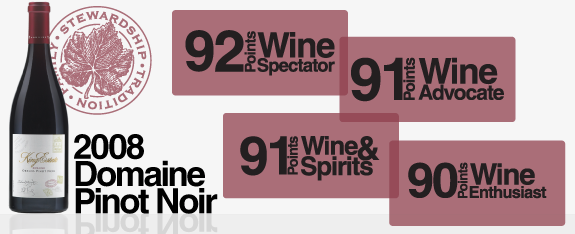
Today, it’s common for people choose wines the same way they choose movies: by consulting what they consider to be expert opinion. While it takes the two thumbs of a film critic held way, way up to fill seats at the local cineplex, it takes a score of 90 points or better to generate real enthusiasm for a wine.
Over the last 30 years assigning numerical scores on the 100 point scale has become the standard tool for navigating the complicated world of wine. The intent may originally have been a noble one: to free wine buyers from the tyranny of sales people eager to push on them whatever they needed to sell. The point system made it easier for wine buyers to make a choice, but has it made them savvier shoppers, made it more likely they will go home with a wine worth its price, or encouraged the exercise of informed, independent judgment? 
I’d argue that our love affair with the point system has had very opposite and unwelcome effects. Instead of promoting these laudable ends numerical scores have become the instruments of a new kind of retail tyranny that’s bad for consumers and the industry too. Why? Because a bogus emphasis on scores diverts attention from the very things that constitute the glory of wine, which might summarized as (a) the fine distinctions and nuanced qualities that distinguish one wine from another; (b) its deep attachment to place; (3) the way it cunningly nuzzles up to our food; (4) its amazing ability to evolve in the bottle and the glass.
Wine writing in a form that most of us would recognize is a 19th century invention, the key figure being André Jullien a Frenchman whose 1820 book combined details on winemaking all over Europe with commentary of the best producers and varieties. After that, the flow of books aiming to share the kind of knowledge that once belonged only the trade with a more general public picked up speed. But it was only in the late 20th century that publications such as Robert M. Parker Jr’s Wine Advocate and Marvin Shanken’s Wine Spectator began to use a 100 point numerical scale to rate wines with a view to giving consumers a precise snapshot of wine quality, as they saw it.  Today we scarcely encounter any bottle without a score hung around its neck. The practice is so widespread that many consumers base their wine-buying decisions exclusively on these scores, with the critical break coming at 90
Today we scarcely encounter any bottle without a score hung around its neck. The practice is so widespread that many consumers base their wine-buying decisions exclusively on these scores, with the critical break coming at 90 thumbs points. With a rating below this wines are hard to sell; at any score above it they sell themselves. At Central Bottle we’ve decided not to either buy or sell wine based on points, and I’ve given you a few reasons why. But in case you’re still addicted to to scores (yes, we see you there by the Barolo shelf checking cellartracker.com), here are a few things you should know about them.
1. Points convey a false sense of precision. The late Chicago Sun-Times film critic Roger Ebert only had two thumbs to use in rating movies but wine reviewers have a 100 points to work with – a number that suggests an enhanced degree of precision when appraising that new blockbuster cabernet. In practice virtually every wine receives a score of between 85 (the effective low) and 95 (the effective high) with only an insignificant number falling outside these limits. With only 10 scores actually available to be assigned, it’s clear that there is far less precision in the 100 point scale than first appears. 
2. The system has a disturbing margin of error. It’s reasonable to assume that due to hills and valleys in wine behavior and variation in taster performance on any given day, a critic may assign one point above or one point below what he or she might have done on another occasion. If true, this means that a wine that scored at 88 one day could easily be rated 87 or 89 on a different occasion. One point in either direction might not seem like a lot, but with only a 10 point spread this amounts to an unconscionable margin of error – or, to put in more scientific terms, a 30% fudgier fudge factor. Looking at it another way, for every wine there isn’t one score but three. Which is the one you can count on?
3. Scoring is a mass-production job. Numerical scores from major wine publications are the result of wines being evaluated in large-scale blind tastings – perhaps 100 wines at a time – where there is little time for reflection, no time for a taster to observe evolution in the glass, and no context ordinary tasters would find familiar. Consumers don’t experience wine this way, so why should we think that events of this kind can result in reliably useful indicators? 
4. A certain profile routinely scores highly. In tasting events of the kind I’ve described, the easiest way for a wine to stand out from others is to make an impact, and the easiest way to make an impact is to have exaggerated features. In these competitions, bigger body, more fruit, richer flavors make wines earn higher scores, while qualities such as elegance, restraint, finesse, and poise go begging. Is it any wonder that in the 30 year period in question we’ve seen a dramatic rise in ripeness at harvest, extract, alcohols, and pigmentation? The point system has changed the face of wine.
5. Points are subject to inflation. Once the system was fully digested by consumers and industry, benchmarks were gradually established with a 90 score emerging as a gaping crevasse separating the lands of Don’t Bother and Must Have. For ambitious properties and brands, an inability to break the 90 point barrier meant failure and even a degree of shame – hence . . .
6. Winemaking became point-making. Consumers may be shocked to learn the lengths vintners will go to wheedle a couple of extra thumbs points from a critic. The techniques include additives designed to darken color and fatten texture. But the strangest work-around of all has to be the rise of consulting services like Enologix that will analyze your wine, predict the score it will receive, and then advise on how to raise it.
Wine by the numbers? We’re giving it two thumbs way, way down.
Reach me at stephenmeuse@icloud.com
Follow Stephen Meuse